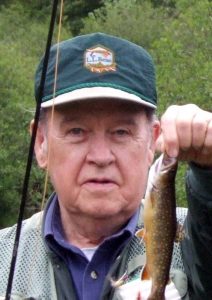Fishing Small Runs
By Al Raychard

I grew up in a time when much of southern Maine seemed a lot less crowded, when you knew your neighbors and a kid could walk to his friend’s house a mile or so down the road and home again in time for supper without fear or mothers worrying about a kid’s safety. During the summer we actually retired each night with the front door and windows wide open to take advantage of the cooling nighttime breezes. We were a rural family, country kids who spent a lot of time outdoors and though we didn’t have 40 channels on TV, the World Wide Web or video games to pacify our time we always found things to do.
Not far from our home was a small brook that drained a wetland area on a neighboring property. Beavers had built a dam near its source creating a small pond but downstream the brook ran clear and clean forming a series of short and long riffles that emptied into deep, dark pools. Over the years the spring run-off had undercut some of the banks, and in places trees had fallen in to divert the water flow forming swirling eddies. Along the banks tall hardwoods and spruce provided shade keeping the brook cool even during the dog-days of summer. I spent countless hours there dunking worms but besides being full of pan-sized native brook trout it was my magical place and the sound of that moving water was like music to my ears. Today, more decades later than I like to think about, whenever I wade into a stream or river with a fly rod in search of trout or salmon the music is still there and I realize it was the hours spent on that brook as a youth that made me such a moving water fan.
I don’t fish small brooks as much as I used to but when I do it’s refreshing to note that despite the world having changed in so many ways things along small trout brooks have pretty much stayed the same. It’s also interesting to realize the lessons learned on a brook in southern Maine decades ago are good general lessons to fish by.
One of the things discovered early on is trout are cover-oriented fish. I’ve found that pretty-much true in the wilds of Labrador to the mountain runs in Pennsylvania to the trout streams in the west. Undercut and shaded overhanging banks, log jams and other obstructions breaking or diverting the currents, pocket water and areas where the water is still moving but out of the stronger main current to name but a few can all produce good results. With that said, the most important thing learned way back when was to look first, to “read” the water before wetting a line. It’s a cardinal rule to fish by.
Another thing that seems to hold true is the further I get from main roads or bushwhack past the end of a trail the better the fishing is apt to be. Exploring areas where anglers seldom tread and sections seldom fished, to have a place all to yourself is one of more enjoyable things about fishing small trout runs.
Looking back, and each time I hit a brook, favorite trout stream or river, even one that is unknown the things discovered as a boy prove their value. The need for a quiet, stealthy approach and maintaining a low profile, how important presentation and precision and making the first cast count are, and how much patience sometimes plays a role in enticing a trout from its station. How the biggest trout are nearly always positioned in the best feeding lanes, at the head of a pool or riffle, near cover or along the edge where deep water meets shallow and fast currents mix with slow.
Indeed, there were a lot of lessons learned back then, one of the most important being it’s not about the size of trout these small runs hold, but the pure, simple joy they offer that really counts. And now, with May upon us and as apple blossoms bloom or about to, and as water levels recede and temperature rise it’s time to wet a line and put those lessons to good use.
For more stories and articles about hunting, fishing and the outdoors, be sure to subscribe to our monthly publication, the Northwoods Sporting Journal.
To access past copies of the Northwoods Sporting Journal in digital format at no charge, click here.
